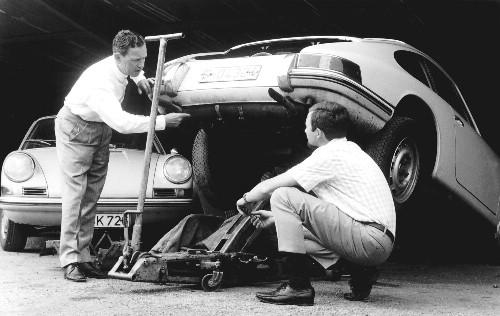Yes, I know Paul Frere said the Weber 40IDA3C carbs were designed for Lancia Flaminia V6 dating from 1957. They were not used on them as they used three double barrel Webers or one Solex triple barrel Type C35 P3 1 2 carb. Possibly the design WAS developed for the Lancia Flaminia Super Sport Zagato (their top of the line, light weight performance offering) but wasn't incorporated for production since three double barrel carbs were more cost effective for the limited production volume of the Super Sport Zagato.
Vittorio Jano designed the 60 degree V6 engines which were used by Lancia and then this engine was revised to be 65 degrees for Ferrari. The V6 Ferraris (Dinos for sports racing, F2 and F1 of the late 1950s & early 1960s) typically used three double barrel Webers except for the 1961 F1 engine Type 156 used in the Shark Nose F1 car Phil Hill became world champion in. Those engines used Weber 40IF3C carbs with a float bowl per barrel and are definitely a different animal from what the 911s use.
The 901/20 competition engine was developed sometime around mid 1964. Two 904s were equipped with the 901/20 engine and taken to Monza in Dec1964 for testing; one used Solex 40PI carbs bored to 44mm and the other used 46IDA3C Webers.
Since Porsche turned to Weber for their competition engines and there were precious few manufacturers in that time frame with a V6 engine I am left with the conjecture the Weber design used on the 911 was available for the 911 but never used by other manufacturers prior to Porsche's use.
I talked with Mike Pierce of Pierce Manifolds and he was not able to shed light on this topic.
Curiously the 46mm throttle bore version seems to be a modification from a design that was probably a 40mm bore size. This is based upon typical carb design has a stepped counter-bore for the main venturi to seat into. A carburetor designed from a clean start to be 46mm would probably have an upper bore of 50mm and throttle plates of 46mm. This would also provide for better air flow through the carb. This leads me to opine the 40mm design pre-existed the 46mm design so when Porsche went to Weber for the 901/20 carburetors I think Weber took the design for the Lancia and bored it out to 46mm.
As for the close spacing of the barrels: economy of design. If spaced vertically above the bores on any engine of size there would be a lot of wasted space between the bores which is poor design for a production application.
Comments or insights?
Picture is of the 40IF3C Weber used on the Type 156 F1 Ferrari:



 Reply With Quote
Reply With Quote

